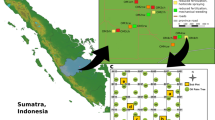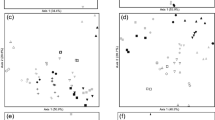Abstract
The effect of freeze-thaw (FT) cycles on Arctic tundra soil bacterial community was studied in laboratory microcosms. FT-induced changes to the bacterial community were followed over a 60-day period by terminal restriction fragment length polymorphism (T-RFLP) profiles of amplified 16S rRNA genes and reverse transcribed 16S rRNA. The main phylotypes of the active, RNA-derived bacterial community were identified using clone analysis. Non-metric multidimensional scaling ordination of the T-RFLP profiles indicated some shifts in the bacterial communities after three to five FT cycles at −2, −5, and −10°C as analyzed both from the DNA and rRNA. The dominating T-RFLP peaks remained the same, however, and only slight variation was generally detected in the relative abundance of the main T-RF sizes of either DNA or rRNA. T-RFLP analysis coupled to clone analysis of reverse transcribed 16S rRNA indicated that the initial soil was dominated by members of Bacteroidetes, Acidobacteria, Alpha-, Beta-, and Gammaproteobacteria. The most notable change in the rRNA-derived bacterial community was a decrease in the relative abundance of a Betaproteobacteria-related phylotype after the FT cycles. This phylotype decreased, however, also in the control soil incubated at constant +5°C suggesting that the decrease was not directly related to FT sensitivity. The results indicate that FT caused only minor changes in the bacterial community structure.







Similar content being viewed by others
References
Altschul SF, Madden TL, Schäffer AA, Zhang J, Zhang Z, Miller W, Lipman DJ (1997) Gapped BLAST and PSI-BLAST: a new generation of protein database search programs. Nucleic Acids Res 25:3389–3402
Duineveld BM, Kowalchuk GA, Keijzer A, van Elsas JD, van Veen JA (2001) Analysis of bacterial communities in the rhizosphere of chrysanthemum via denaturing gradient gel electrophoresis of PCR-amplified 16S rRNA as well as DNA fragments coding for 16S rRNA. Appl Environ Microbiol 67:172–178
Dunbar J, Ticknor LO, Kuske CR (2001) Phylogenetic specificity and reproducibility and new method for analysis of terminal restriction fragment profiles of 16S rRNA genes from bacterial communities. Appl Environ Microbiol 67:190–197
Fegatella F, Lim J, Kjelleberg S, Cavicchioli R (1998) Implications of rRNA operon copy number and ribosome content in the marine oligotrophic ultramicrobacterium Sphingomonas sp. strain RB2256. Appl Environ Microbiol 64:4433–4438
Feng X, Nielsen LL, Simpson M (2007) Responses of soil organic matter and microorganisms to freeze-thaw cycles. Soil Biol Biochem 39:2027–2037
Fierer N, Bradford MA, Jackson RB (2007) Toward an ecological classification of soil bacteria. Ecology 88:1354–1364
Galtier N, Gouy M, Gautier C (1996) SEAVIEW and PHYLO_WIN: two graphic tools for sequence alignment and molecular phylogeny. Comput Appl Biosci 12:543–548
Griffiths RI, Whiteley AS, O’Donnell AG, Bailey MJ (2000) Rapid method for coextraction of DNA and RNA from natural environments for analysis of ribosomal DNA and rRNA-based microbial community composition. Appl Environ Microbiol 66:5488–5491
Henry HAL (2007) Soil freeze-thaw cycle experiments: trends, methodological weaknesses and suggested improvements. Soil Biol Biochem 39:977–986
Janssen PH (2006) Identifying the dominant soil bacterial taxa in libraries of 16S rRNA and 16S rRNA genes. Appl Environ Microbiol 72:1719–1728
Johnson JL (1994) Similarity analysis of DNAs. Methods for general and molecular bacteriology. In:Gerhardt P, Murray RGE, Wood WA, & Krieg NR (eds), American Society for Microbiology, Washington, D.C., USA, pp 655–682
Kattsov VM, Källén E, Cattle H et al (2005) Chapter 4: Future climate change: modeling and scenarios for the Arctic. Arctic Climate Impact Assessment. Cambridge University Press, New York, pp 99–150
Kerkhof L, Kemp P (1999) Small ribosomal RNA content in marine Proteobacteria during non-steady-state growth. FEMS Microbiol Ecol 30:253–260
Kerkhof LJ, Häggblom MM (2008) Detecting active bacteria involved in biodegradation in the environment. In: Diaz E (ed) Microbial Biodegradation: Genomics and Molecular Biology, pp. 55-70, Caister Academic Press, Norfolk
Kerkhof L, Ward BB (1993) Comparison of nucleic acid hybridization and fluorometry for measurement of the relationship between RNA/DNA ratio and growth rate in a marine bacterium. Appl Environ Microbiol 59:1303–1309
Koponen HT, Jaakkola T, Keinänen-Toivola MM, Kaipainen S, Tuomainen J, Servomaa K, Martikainen PJ (2006) Microbial communities, biomass, and activities in soils as affected by freeze thaw cycles. Soil Biol Biochem 38:1861–1871
Larsen KS, Jonasson S, Michelsen A (2002) Repeated freeze-thaw cycles and their effects on biological processes in two arctic ecosystem types. Appl Soil Ecol 21:187–195
Lipson DA, Monson RK (1998) Plant-microbe competition for soil amino acids in the alpine tundra: effects of freeze-thaw and dry-rewet events. Oecologia 113:406–414
Lipson DA, Schmidt SK, Monson RK (2000) Carbon availability and temperature control the post-snowmelt decline in alpine soil microbial biomass. Soil Biol Biochem 32:441–448
Lipson DA, Schmidt SK (2004) Seasonal changes in an alpine soil bacterial community in the Colorado Rocky Mountains. Appl Environ Microbiol 70:2867–2879
Lipson DA (2007) Relationships between temperature responses and bacterial community structure along seasonal and altitudinal gradients. FEMS Microbiol Ecol 59:418–427
McCune B, Mefford MJ (1999) Multivariate analysis of Ecological data, Version 4.25. MjM Software, Gleneden Beach, Oregon, USA
Mengoni A, Tatti W, Decorosi F, Viti C, Bazzicalupo M, Giovannetti L (2005) Comparison of 16S rRNA and 16S rDNA T-RFLP approaches to study bacterial communities in soil microcosms treated with chromate as perturbing agent. Microbiol Ecol 50:375–384
Männistö M, Tiirola M, Häggblom M (2007) Bacterial communities in Arctic fjelds of Finnish Lapland are stable but highly pH dependent. FEMS Microbiol Ecol 59:452–465
Nogales B, Moore ERB, Llobet_Brossa E, Rossello-Mora R, Amann R, Timmis KN (2001) Combined use of 16S ribosomal DNA and 16S rRNA to study the bacterial community of polychlorinated biphenyl-polluted soil. Appl Environ Microbiol 67:1874–1884
Pesaro M, Widmer F, Nicollier G, Zeyer J (2003) Effect of freeze-thaw stress during soil storage on microbial communities and methidation degradation. Soil Biol Biochem 35:1049–1061
Perrière G, Gouy M (1996) WWW-Query: an on-line retrieval system for biological sequence banks. Biochimie 78:364–369
Poulsen LK, Ballard G, Stahl DA (1993) Use of rRNA fluorescence in situ hybridization for measuring the activity of single cells in young and established biofilms. Appl Environ Microbiol 59:1354–1360
Schimel JP, Clein JS (1996) Microbial response to freeze-thaw cycles in tundra and taiga soils. Soil Biol Biochem 28:1061–1066
Schimel JP, Mikan C (2005) Changing microbial substrate use in Arctic tundra soils through a freeze-thaw cycle. Soil Biol Biochem 37:1411–1418
Sharma S, Szele S, Schilling R, Munch JC, Schloter M (2006) Influence of freeze-thaw stress on the structure and function of microbial communities and denitrifying populations in soil. Appl Environ Microbiol 72:2148–2154
Sjursen H, Michelsen A, Holmstrup M (2005) Effects of freeze-thaw cycles on microarthropods and nutrient availability in a sub-Arctic soil. Appl Soil Ecol 28:79–93
Soulides DA, Allison FE (1961) Effect of drying and freezing soils on carbon dioxide production, available mineral nutrients, aggregation, and bacterial population. Soil Sci 91:291–298
Thompson JD, Gibson TJ, Plewniak F, Mougin FJ, Higgins DG (1997) The clustalX windows interface: flexible strategies for multiple sequence alignment aided by quality analysis tools. Nucleic Acids Res 24:4876–4882
Wagner R (1994) The regulation of ribosomal RNA synthesis and bacterial cell growth. Arch Microbiol 161:100–109
Walker VK, Palmer GR, Voordouw G (2006) Freeze-thaw tolerance and cues to the winter survival of soil community. Appl Environ Microbiol 72:1784–1792
Wallenstein MD, McMahon S, Schimel J (2007) Bacterial and fungal community structure in Arctic tundra tussock and shrub soils. FEMS Microbiol Ecol 59:428–435
Yergeau W, Kowalchuk GA (2008) Responses of Antarctic soil microbial communities and associated functions to temperature and freeze-thaw cycle frequence. Env Microbiol 10:2223–2235
Acknowledgements
We thank Riitta Nielsen and Heidi Kontio for their help in the DNA/RNA extractions. This study was funded by the Academy of Finland (grants 106208, 123725, 105860, and 120089).
Author information
Authors and Affiliations
Corresponding author
Rights and permissions
About this article
Cite this article
Männistö, M.K., Tiirola, M. & Häggblom, M.M. Effect of Freeze-Thaw Cycles on Bacterial Communities of Arctic Tundra Soil. Microb Ecol 58, 621–631 (2009). https://doi.org/10.1007/s00248-009-9516-x
Received:
Accepted:
Published:
Issue Date:
DOI: https://doi.org/10.1007/s00248-009-9516-x




